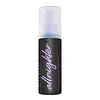What's inside
What's inside
 Key Ingredients
Key Ingredients

No key ingredients
 Benefits
Benefits

 Concerns
Concerns

No concerns
 Ingredients Side-by-side
Ingredients Side-by-side

Water
Skin ConditioningAlcohol Denat.
AntimicrobialPvp
Emulsion StabilisingDimethicone PEG-7 Phosphate
CleansingPPG-3 Benzyl Ether Myristate
EmollientPolyhydroxystearic Acid
EmulsifyingDipropylene Glycol
HumectantIsononyl Isononanoate
EmollientEthylhexyl Isononanoate
EmollientCaprylyl Glycol
EmollientSodium Cocamidopropyl Pg-Dimonium Chloride Phosphate
CleansingMethyl Methacrylate Crosspolymer
Glycereth-5 Lactate
EmollientPhenylpropanol
MaskingPropanediol
SolventMethyl Diisopropyl Propionamide
MaskingSodium Hydroxide
BufferingParfum
MaskingAloe Barbadensis Leaf Juice
Skin ConditioningMaltodextrin
AbsorbentPoloxamer 407
EmulsifyingPentaerythrityl Tetra-Di-T-Butyl Hydroxyhydrocinnamate
AntioxidantTocopherol
AntioxidantPotassium Sorbate
PreservativeSodium Benzoate
MaskingWater, Alcohol Denat., Pvp, Dimethicone PEG-7 Phosphate, PPG-3 Benzyl Ether Myristate, Polyhydroxystearic Acid, Dipropylene Glycol, Isononyl Isononanoate, Ethylhexyl Isononanoate, Caprylyl Glycol, Sodium Cocamidopropyl Pg-Dimonium Chloride Phosphate, Methyl Methacrylate Crosspolymer, Glycereth-5 Lactate, Phenylpropanol, Propanediol, Methyl Diisopropyl Propionamide, Sodium Hydroxide, Parfum, Aloe Barbadensis Leaf Juice, Maltodextrin, Poloxamer 407, Pentaerythrityl Tetra-Di-T-Butyl Hydroxyhydrocinnamate, Tocopherol, Potassium Sorbate, Sodium Benzoate
Water
Skin ConditioningPropanediol
SolventGlycerin
HumectantAloe Barbadensis Leaf Juice
Skin ConditioningPvp
Emulsion StabilisingAnastatica Hierochuntica Extract
AstringentPhenoxyethanol
PreservativeEthylhexylglycerin
Skin ConditioningPanthenol
Skin ConditioningPPG-26-Buteth-26
Skin ConditioningPEG-40 Hydrogenated Castor Oil
EmulsifyingXylitylglucoside
HumectantAnhydroxylitol
HumectantOpuntia Ficus-Indica Stem Extract
Skin ConditioningLactobacillus Ferment
Skin ConditioningXylitol
HumectantGlucose
HumectantSodium Hydroxide
BufferingCitric Acid
BufferingSodium Benzoate
MaskingPotassium Sorbate
PreservativeWater, Propanediol, Glycerin, Aloe Barbadensis Leaf Juice, Pvp, Anastatica Hierochuntica Extract, Phenoxyethanol, Ethylhexylglycerin, Panthenol, PPG-26-Buteth-26, PEG-40 Hydrogenated Castor Oil, Xylitylglucoside, Anhydroxylitol, Opuntia Ficus-Indica Stem Extract, Lactobacillus Ferment, Xylitol, Glucose, Sodium Hydroxide, Citric Acid, Sodium Benzoate, Potassium Sorbate
 Reviews
Reviews

Ingredients Explained
These ingredients are found in both products.
Ingredients higher up in an ingredient list are typically present in a larger amount.
Aloe Barbadensis Leaf Juice comes from leaves of the aloe plant. Aloe Barbadensis Leaf Juice is best known for helping to soothe sunburns. It is also anti-inflammatory, moisturizing, antiseptic, and can help heal wounds.
Aloe is packed with good stuff including Vitamins A, C, and E. These vitamins are antioxidants, which help fight free-radicals and the damage they may cause. Free-radicals are molecules that may damage your skin cells, such as pollution.
Aloe Barbadensis Leaf Juice also contains sugars. These sugars come in the form of monosaccharides and polysaccharides, folic acid, and choline. These sugars are able to help bind moisture to skin.
It also contains minerals such as calcium, 12 anthraquinones, fatty acids, amino acids, and Vitamin B12.
Learn more about Aloe Barbadensis Leaf JuicePotassium Sorbate is a preservative used to prevent yeast and mold in products. It is commonly found in both cosmetic and food products.
This ingredient comes from potassium salt derived from sorbic acid. Sorbic acid is a natural antibiotic and effective against fungus.
Both potassium sorbate and sorbic acid can be found in baked goods, cheeses, dried meats, dried fruit, ice cream, pickles, wine, yogurt, and more.
You'll often find this ingredient used with other preservatives.
Learn more about Potassium SorbatePropanediol is an all-star ingredient. It softens, hydrates, and smooths the skin.
It’s often used to:
Propanediol is not likely to cause sensitivity and considered safe to use. It is derived from corn or petroleum with a clear color and no scent.
Learn more about PropanediolPvp is a water-soluble synthetic polymer and common hairstyling ingredient. It is a film-forming ingredient and used to "hold" specific shapes of hair.
Pvp is less effective in high-humidity. It tends to draw moisture, but this moisture dismantles the structure and "hold".
Sodium Benzoate is a preservative. It's used in both cosmetic and food products to inhibit the growth of mold and bacteria. It is typically produced synthetically.
Both the US FDA and EU Health Committee have approved the use of sodium benzoate. In the US, levels of 0.1% (of the total product) are allowed.
Sodium benzoate works as a preservative by inhibiting the growth of bacteria inside of cells. It prevents the cell from fermenting a type of sugar using an enzyme called phosphofructokinase.
It is the salt of benzoic acid. Foods containing sodium benzoate include soda, salad dressings, condiments, fruit juices, wines, and snack foods.
Studies for using ascorbic acid and sodium benzoate in cosmetics are lacking, especially in skincare routines with multiple steps.
We always recommend speaking with a professional, such as a dermatologist, if you have any concerns.
Learn more about Sodium BenzoateSodium Hydroxide is also known as lye or caustic soda. It is used to adjust the pH of products; many ingredients require a specific pH to be effective.
In small amounts, sodium hydroxide is considered safe to use. However, large amounts may cause chemical burns due to its high alkaline.
Your skin has a natural pH and acid mantle. This acid mantle helps prevent harmful bacteria from breaking through. The acid mantle also helps keep your skin hydrated.
"Alkaline" refers to a high pH level. A low pH level would be considered acidic.
Learn more about Sodium HydroxideWater. It's the most common cosmetic ingredient of all. You'll usually see it at the top of ingredient lists, meaning that it makes up the largest part of the product.
So why is it so popular? Water most often acts as a solvent - this means that it helps dissolve other ingredients into the formulation.
You'll also recognize water as that liquid we all need to stay alive. If you see this, drink a glass of water. Stay hydrated!
Learn more about Water